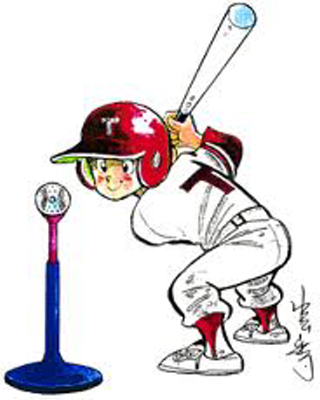Bats: Use one suitable for you
Get the right sized bat for YOU

We supply each team with an assortment of bats in an effort to have at least one suitable for each player. If the supplied equipment isn't suitable, then one of the coaching staff should contact the league convenor to get a replacement. Some players use their own bats, which is fine but they must be prepared to share with other players - i.e. players from BOTH teams. If not prepared to share, then personal bats should not be brought to the game/practice. Note: No one is asked to share personally owned equipment such as helmets or gloves.
Bat Sizes
| Your height (inches) | ||||||||||
| Your weight (pounds) | 36-40 | 41-44 | 45-48 | 49-52 | 53-56 | 57-60 | 61-64 | 65-68 | 69-72 | 73+ |
| Bat length | ||||||||||
| less than 60 | 26" | 27" | 28" | 29" | 29" | |||||
| 61-70 | 27" | 27" | 28" | 29" | 30" | 30" | ||||
| 71-80 | 28" | 28" | 29" | 30" | 30" | 31" | ||||
| 81-90 | 28" | 29" | 29" | 30" | 30" | 31" | 32" | |||
| 91-100 | 28" | 29" | 30" | 30" | 31" | 31" | 32" | |||
| 101-110 | 29" | 29" | 30" | 30" | 31" | 31" | 32" | |||
| 111-120 | 29" | 29" | 30" | 30" | 31" | 31" | 32" | |||
| 121-130 | 29" | 29" | 30" | 30" | 31" | 32" | 33" | 33" | ||
| 131-140 | 29" | 30" | 30" | 31" | 31" | 32" | 33" | 33" | ||
| 141-150 | 30" | 30" | 31" | 31" | 32" | 33" | 33" | |||
| 151-160 | 30" | 31" | 31" | 32" | 32" | 33" | 33" | 33" | ||
| 161-170 | 31" | 31" | 32" | 32" | 33" | 33" | 34" | |||
| 171-180 | 32" | 33" | 33" | 34" | 34" | |||||
| 180+ | 33" | 33" | 34" | 34" | ||||||
Note: In general, bigger, stronger players usually prefer a heavier bat since they reap benefits from both the heft and swing power. Smaller and younger players should use a lighter bat to generate a quicker swing and provide better control.
|
| Weight Minimum | Weight Maximum | Length Minimum | Length Maximum |
|
| 6-7 | 17 Ounces | 19 Ounces | 24 Inches | 28 Inches | 2 ¼ |
| 8 | 19 Ounces | 21 Ounces | 27 Inches | 30 Inches | 2 ¼ |
| 9 | 20 Ounces | 23 Ounces | 28 Inches | 30 Inches | 2 ¼ |
| 10 | 20 Ounces | 23 Ounces | 28 Inches | 31 Inches | 2 ¼ |
| 11 | 21 Ounces | 24 Ounces | 29 Inches | 31 Inches | 2 ¼ to 2 5/8 |
| 12 | 23 Ounces | 25 Ounces | 30 Inches | 33 Inches | 2 ¼ to 2 ¾ |
| 13-14 | 23 Ounces | 28 Ounces | 30 Inches | 33 Inches | 2 ¼ to 2 ¾ |
| 15 + | 24 Ounces | 30 Ounces | 30 Inches | 34 Inches | 2 ¾ |
Bat Taper: The bat's taper is the diameter of the bat's handle. A bigger bat taper can reduce the sting that occurs when the ball isn't hit on the sweet spot but it also increases the overall weight of the bat. Standard bats are tapered 31/32 of a inch.
While a properly sized bat is important, learning how to hold the bat, get ready and swing properly are all priorities and should be practised --- otherwise the bat only "looks good".
